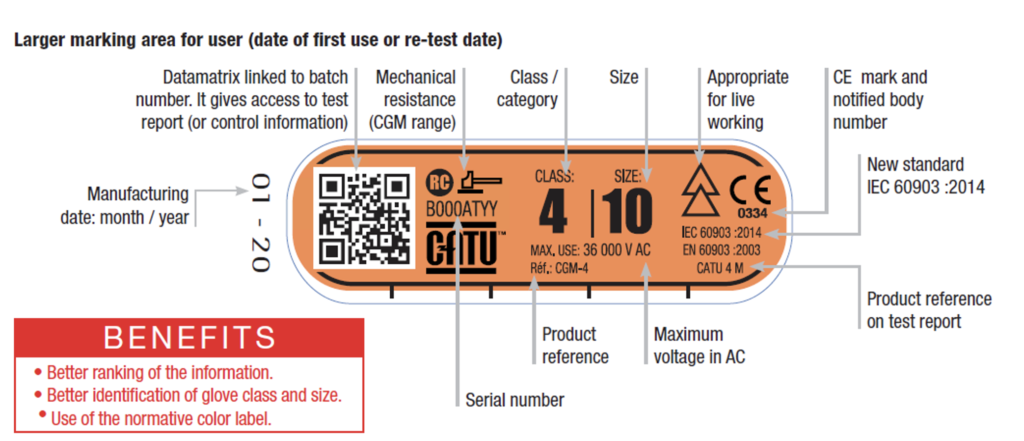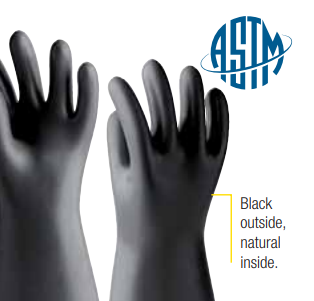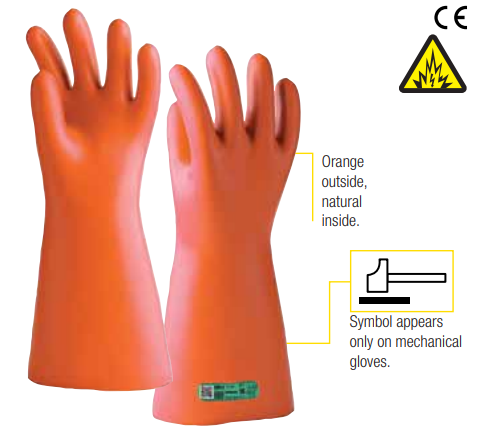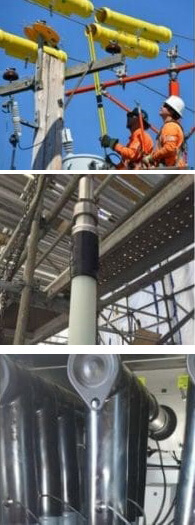Insulating Gloves (LV MV HV 11kV 33kV Electrical Gloves)

Insulating Gloves (LV MV HV 11kV 33kV Gloves)
Thorne & Derrick | Distributed from Stock | Approved Supplier | UK & Export Sales
Insulating Gloves
Electrical Gloves | Class 00 to Class 4 Hand Protection Against Electrical Shock
Insulating gloves (also referred to as electrical gloves) offer personal hand protection for workers against electrical shocks when working near or on live wires, cables and electrical equipment including substation switchgear and transformers – risk assessment identifies electrical shock during the jointing of cables or excavating around live cables as a potential cause of accident which can be avoided when appropriate safety precautions and gloves are worn.
Where protection against arc incident is required please see arc flash gloves with 50cal protection (Class 4) and for complete protection refer to our range of arc flash clothing.
Each pair of electrical rubber insulating gloves must comply with the IEC 60903 and EN 60903 standards and as a result of this, each pair undergoes voltage, ageing and mechanical testing.
There are 3 main types of insulating gloves:-
- Standard Insulating Gloves – rubber gloves that provide very high dielectric properties which must be used in conjunction with leather gloves
- Mechanical Insulating Gloves – enhanced impact and excellent mechanical protection against tears and punctures without requirement for protective overgloves
- ASTM D120 Gloves – American Society for Testing and Materials is the world’s largest source of standards (arrived at by voluntary consensus) for materials and goods
The ergonomic design of CATU insulating gloves makes the product suitable for any type of hand and are soft and supple to enable excellent dexterity and usability.
In addition there are sizes ranging from 7 – 12 in order to cover all requirements both male and female.

Bi-colour Gloves
Other key features of the electrical gloves include bi-colour to easily detect and abrasion, cut or tear to the gloves that could alter the dielectric properties of the product – this includes class 1 / 2 / 3 / 4 insulating gloves.
There is also clear marking and a rolled cuff on some gloves to allow for easy handling and comfort.
Traceability of the insulating gloves enabling to easily know if the gloves are compliant, the next re-test dates, the test reports, user instruction, data-sheet.
The electrical gloves are generally used in conjunction with a range of electrical safety equipment including insulating boots (dielectric) and insulating matting when working on or in front of switchgear.
The following video provides an overview of the CATU Electrical range of insulating gloves for all voltage classes (Class 00 500V to Class 4 36kV) – contact Thorne & Derrick for customer service, quotations and stock availability.
➡ To ensure the correct selection and comfortable fit please use and download the sizing guide for electrical insulating gloves.
INSULATING GLOVES
Selection Of Correct Electrical Gloves
Insulating gloves should be selected according to their class which corresponds to the voltage level used – additionally the gloves are classified into categories according to environmental resistance properties detailed below.
- Class
- Voltage
- Product Colour
- Size – between 7-12 for either male of female use
- Classifications & Standards
When selecting the correct insulating gloves all of the above factors are vital to consider in order to achieve the adequate level of electrical protection required.

Insulating Rubber Gloves
In addition, some electrical gloves will also require an under-glove for comfort or a leather over-glove to maintain product longevity.
Inspection and storage of insulating gloves is also a vital factor to consider as all gloves must be visibly inspected after each inflation and before each use.
This is to make sure there are no tears or abrasion to the gloves prior to use, maintaining their dielectric properties.

Rolled Cuffs
Insulating rubber gloves are also categorised by environmental resistance properties for protection against acid, oil, o-zone and very low temperatures.
- A – Acid
- H – Oil
- Z – O-Zone
- R – Acid, Oil and O-Zone
- C – Very Low Temperatures

Standard Insulating Gloves
Insulating Gloves – Class & Category
The following electrical gloves manufactured by CATU Electrical do not provide mechanical protection and must be used with silicon leather glove covers or over-gloves.
| Insulating Gloves Class | CATU Electrical Code | Glove Category | Thickness | Length | Colour | AC | kV | DC |
| Class 00 | CATU CG-05 | AZC | 0.5mm | 360mm | Beige | ≤ 500V | 0.5kV | 750V |
| Class 0 | CATU CG-10 | AZC | 1mm | 360mm | Beige | ≤ 1000V | 1kV | 1500V |
| Class 1 | CATU CG-1 | RC | 1.5mm | 360mm | Bi-Colour | ≤ 7500V | 7.5kV | 11,250V |
| Class 2 | CATU CG-2 | RC | 2.3mm | 360mm | Bi-Colour | ≤ 17000V | 17.5kV | 25,500V |
| Class 3 | CATU CG-3 | RC | 2.9mm | 360mm | Bi-Colour | ≤ 26500V | 26.5kV | 39,750V |
| Class 4 | CATU CG-4 | RC | 3.6mm | 410mm | Bi-Colour | ≤ 36000V | 36kV | 54,000V |
Standard Electrical Insulating Gloves with Short Design
Use silicon leather over gloves, ref. CATU CG-981 (Class 0 and 00), CG-991 (Class 1 to 4).
Short Gloves 28cm | Rolled Cuff
| Insulating Gloves Class | CATU Electrical Code | Glove Category | Voltage (AC) | Voltage (DC) | Colour | Length (mm) | Arc Flash class 00 only | DC |
| Class 00 | CG-00-(*)-R-28 | AZC | ≤ 500V | ≤ 750V | Red exterior, beige interior | 280 | 6 cal, class 1. Battery acid resistance | 750V |
| Class 0 | CG-0-(*)-R-28 | AZC | ≤ 1000V | ≤ 1500V | 280 | 1500V |
Electrical Gloves
EN 60903 Insulating
EN 60903 is the European standard which classes and categorises electrical insulating gloves worn to prevent and protect against electrical shock – the working title of EN 60903 is ‘Live Working. Gloves Of Insulating Material’.
EN 60903 includes a range of tests, some of which are optional and only carried out if a specific property is to be claimed.
The mandatory glove test assessments include checks on dimensions, finish, marking and packaging, plus tests on basic mechanical performance, dielectric properties, ageing treatments and thermal tests.
The basic mechanical performance tests cover tensile strength and elongation at break and puncture resistance. Several performance levels are available for the dielectric or electrical insulation tests (see below Table 1).
The thermal requirements consist of a flame retardancy test on the glove fingers and a cold crack test carried out after exposure to a minus 25ºC environment. Optional tests for gloves with special properties, together with their associated marking codes, are listed in Table 2.
Electrical Insulation Tests For Gloves Table 1
| Class Of Gloves
|
Maximum Voltage Use AC DC | Test Voltage AC Proof | Test Voltage AC Withstand |
| 00 | 500V ac | 750V dc | 2.5kV | 5kV |
| 0 | 1000V ac | 1500V dc | 5kV | 10kV |
| 1 | 7500V ac | 11250V dc | 10kV | 20kV |
| 2 | 17000V ac | 25500V dc | 20kV | 30kV |
| 3 | 26500V ac | 39750V dc | 30kV | 40kV |
| 4 | 36000V ac | 54000V dc | 40kV | 50kV |
Special Properties Of Gloves Table 2
| Special Property Of Insulating Glove | Category Marking Code |
| Acid Resistance | A |
| Oil Resistance | H |
| Ozone Resistance | Z |
| Acid, Oil & Ozone Resistance | R |
| Extreme Low Temperature | C |
♦ Category R combines the characteristics of Categories A, H and Z.

CATU Electrical Insulating Gloves – Markings
ASTM D120 Insulating Gloves

ASTM D120 Gloves
CATU Electrical also manufacture a range of ASTM D120 compliant insulating gloves.
ASTM D120 standard and specification covers manufacturing and testing of rubber insulating gloves for protection of workers from electrical shock. 2 types of gloves are provided and are designated as Type I, non-resistant to ozone, and Type II, resistant to ozone.
Six classes of gloves differing in electrical characteristics are provided and are designated as Class 00, Class 0, Class 1, Class 2, Class 3, and Class 4.
The following tests shall be performed: i) ac proof test ii) ac breakdown test iii) ac moisture absorption/proof test iv) dc proof test v) dc breakdown test vi) ozone resistance test vii) chemical tests viii) tensile strength ix) tear resistance test and x) puncture resistance test.
| CATU Electrical Code | Insulating Glove Class | Voltage | Type | Inches | Colour |
| CATU CGA-00 | Class 00 | ≤ 500V | 1 | 14 | Black |
| CATU CGA-0 | Class 0 | ≤ 1000V | 1 | 14 | Black |
| CATU CGA-1 | Class 1 | ≤ 7500V | 1 | 14 | Bi-Colour |
| CATU CGA-2 | Class 2 | ≤ 17000V | 1 | 14 | Bi-Colour |
| CATU CGA-3 | Class 3 | ≤ 26500V | 1 | 14 | Bi-Colour |
| CATU CGA-4 | Class 4 | ≤ 36000V | 1 | 16 | Bi-Colour |
Insulating Gloves With Mechanical Protection
Insulating gloves with higher mechanical protection that standard rubber insulating gloves for working with full electrical safety without the requirement to over protect the gloves with leather type overgloves.
CATU mechanical insulating gloves are arc flash tested in accordance with IEC 61482-1-2 Class 2 (ASTM F2675/F2675M).

Mechanical Insulating Gloves
| CATU Electrical Code | Insulating Glove Class | Voltage | Category | Glove Length | Colour |
| CATU CGM-00 | Class 00 | ≤ 500V | RC | 360mm | Bi-Colour |
| CATU CGM-0 | Class 0 | ≤ 1000V | RC | 360mm | Bi-Colour |
| CATU CGM-1 | Class 1 | ≤ 7500V | RC | 360mm | Bi-Colour |
| CATU CGM-2 | Class 2 | ≤ 17000V | RC | 360mm | Bi-Colour |
| CATU CGM-3 | Class 3 | ≤ 26500V | RC | 360mm | Bi-Colour |
| CATU CGM-4 | Class 4 | ≤ 36000V | RC | 410mm | Bi-Colour |
CATU GLOVES
T&D are approved vendors to most UK DNO’s and are able to help specify and advise on the correct insulating glove, voltage protection and type of glove required.
- Double Triangle Symbol – gloves marked with this symbol are suitable for live working according to IEC 60 417-5216.
- Mechanical Hammer Symbol – the insulating gloves provide additional mechanical and worker protection against impact.
For the UK utilities network, working with live lines and carrying out inspections on overhead lines is commonplace with this type of work being carried out daily.
Electrical safety and worker protection is vital to prevent injury caused by arc flash explosions or electric shock accidents occurring.
Hot glove working traditionally consists of workers carrying out essential live line maintenance and over head line working to ensure uninterrupted supply of power.
CATU insulating gloves provide the dielectric protection required for LV-HV cable jointing, live-line, substation, overhead and underground cable installations protecting against electrical shock – electrical tested insulating gloves for live working should be carefully washed after use, ensuring the rubber surface is thoroughly cleaned and dried completely using French Chalk.
Typical installations and work that require the protection provided by insulating gloves include:
- Installation of low and high voltage electrical systems
- Cable laying (LV,11kV,33kV,132kV)
- Cable jointing (dead LV, live LV,11kV, 33kV, 132kV)
- Substation installation (up to 11kV/415V)
- Overhead lines wooden pole and/or steel tower (up to 132kV)
- Civil engineering works including excavation, cable laying and backfilling
Storage & Inspection Of Insulating Gloves
All insulating gloves must be subject to visible inspection after inflation and before each use. For Class 0 and Class 00 the glove tests comprise of an air inflation test and a visual inspection when the glove is inflated. The dielectric test is not required but can be organised at the end users request.
For Class 1, 2, 3 and 4 insulating gloves even when in storage the gloves should not be used without having been tested within the last 6 months. Normal testing periods for gloves is between 60 and 90 days. An inspection of the inside condition of the glove is also recommended by CATU Electrical – gloves should be stored in their packaging without being compressed, folded or deformed. Gloves should not be stored near a heat source with a temperature of 10 to 21°C.
Standard insulating gloves are coloured either beige (Class 00 | Class 1) or bi-colour with red outside and natural inside ( Class 1 | Class 2 | Class 3 | Class 4).
CATU guarantees storage of gloves for up to 12 months * without the need to retest them. So, management is optimised and simplified.
* In compliance with the International Standard IEC 60903:2014, the recommendations established by the manufacturer on the storage and periodic maintenance of insulating gloves prevail in the informative annex. CATU extends the duration of storage for all its ranges and for each class of gloves to 12 months, from their date of manufacture. From the date of first commissioning, the usual recommendations for use and periodic maintenance remain unchanged. Gloves are delivered in an anti-UV bag.
Electrical Insulating & Arc Flash Protection Gloves
There is often misunderstanding about hand protection requirements and the type of glove required to provide protection against electrical shock (electrocution) or arc flash hazards. Electrical safety rubber insulating gloves provide voltage protection and arc-rated or flame-resistant gloves provide heat protection – it is critical to understand that voltage protection is provided by correctly tested rubber insulating gloves only. Arc-rated or flame resistant gloves DO NOT provide dielectric protection. Performing voltage testing or other energized and potentially energized work tasks, including absence of voltage testing, must NEVER be done using these types of gloves.



















